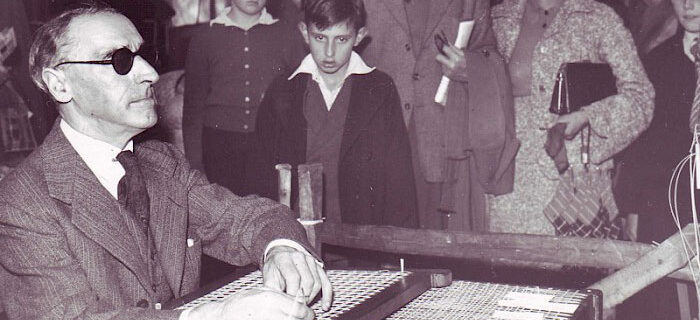
Warwickshire Association for the Blind (WAB) was formed at a meeting of the Midland Counties Union of Institutions and Societies for the Blind held at Leamington Town Hall on 2nd June 1911. The charity was presided over by Lord Algernon Percy, High Sheriff of Warwickshire and Chairman of Warwickshire County Council (WCC).
Local correspondents and visitors were appointed to cover all the areas of the county (not Birmingham). They identified specific individuals, including children, who needed help. Small allowances were granted to people from Government funds.
Training was provided at Birmingham Institute for the Blind. A major aim was to find work for trained adults and to provide financial help to enable children to have hospital treatment and start training as early as possible. Braille magazines were circulated and Leamington Library paid for the carriage of hampers from the National Lending Library for the Blind.
By 1917, 92 blind men, 126 blind women and 9 blind children had been identified. In 1918 WAB was recognised on the register of Approved Societies and Agencies for the Blind.
On 1st September 1925 Miss Simpson, WAB’s first home teacher, was appointed. She travelled around Warwickshire by bicycle and train, carrying out 635 visits in the first 6 months. By 1929 she was doing 100 visits per month. In addition she taught Braille, Music and Raffia. In 1926 the first talking books were produced on gramophone records, with a typical book fitting on to ten 12” double-sided records.
WAB entered an agreement with a shop in Warwick Street, Leamington for the sale of articles made by Blind home workers. White sticks, which were coming into common use at this time were also sold at 10½d. In 1933 Lord Algernon Percy died, to be replaced as President by Mrs Katherine Heber-Percy, his daughter, who had been Secretary. In 1940-41 approximately 100 blind evacuees passed through the hands of the Association, of whom 60 remained in the area.
By the end of the war, 624 people were registered blind with 102 of them being in employment. WAB ran social centres in Leamington, Rugby, Shirley, Sutton Coldfield and Tamworth. Able-bodied blind people were encouraged to register under the Disabled Persons Employment Act.
With the creation of the welfare state and the introduction of the National Assistance Act in 1948 WAB’s role changed. Prior to 1950 the Honorary Secretary of WAB, Miss Crossley, had been the Principal Social Worker for the County but by 1950, WAB functioned purely as an organisation administering voluntary funds for the blind. Most of this money came from the Midland Societies for the Blind.
In 1950 WAB purchased Huntley Lodge, Northumberland Road, Leamington as a home for 22 elderly blind people, to be run by the County Council. The money for this came from the Midland Societies for the Blind, which was funded in part by Warwickshire Miners.
By 1953 WAB had purchased 26 Talking Book machines for loan across the county.
The 1950s saw the explosion of holiday camps and WAB started to provide holidays for VIPs. By 1958 coaches ran at fortnightly intervals and by 1960, 179 blind and 92 sighted people were taken by coach to Burnham-on-Sea or Bournemouth at a cost of £11.18s.1d per person.
Mrs Heber-Percy, President since 1933, died. WAB’s constitution was extended to activities for the partially sighted but finances were tight. Many local organisations gave support.
1969-1971 marked the introduction of new-style welfare services and the formation of Social Service Departments. In 1970 the Chronically Sick and Disabled Persons Act was passed and the publicity led to an increase in the number of people on the Register of the Blind to 1,115.
Major changes resulted from the loss of Solihull, Sutton Coldfield and Meriden when the new administrative county of Warwickshire was formed in 1974. In 1978 WAB finally became independent of the County Council.
In 1980 Huntley Lodge was sold and the money returned to WAB. By 1980 there were five Branches and five local Talking Newspapers.
1981-86 was a time of great expansion under Dr Fred Reid as Chairman and George Marshall as Vice-Chairman. WAB now acquired its own Resource Centre in Puckering’s Lane, Warwick in 1983 with an official opening by the Queen Mother in 1988.
Staff numbers increased to seven and by 1985 there was a Voluntary Help Organiser, looking after 550 Volunteers.
An RNIB report published in 1991 showed that there were three times more visually impaired people than previously thought. A new Development Plan for WAB was written and the previous informal agency arrangement with Social Services was formalised.
Social Services delegated the Register for Blind and Partially Sighted People to WAB and by 1995, 2,525 people were registered.
Warwickshire Talking Book Service was set up in 1993 and by 2000 it had 454 users. There were also new clubs in Leamington and Rugby.
Financial problems led to the sale of the Puckering’s Lane site and significant staff restructuring in 2004. The office moved to rented premises in Berrington Road, Leamington Spa.
Finances improved after 2004. WAB became a Company Limited by Guarantee (while remaining a Registered Charity) in April 2008. In 2009 WAB rented new offices, back in Warwick.
Warwickshire Talking Book Service was closed in 2010 due to duplication from national providers such as Calibre. The volunteers were given permission to run the service as De Montfort Talking Books until March 2019.
A weekly Drop-in Centre (Vision Support Centre) was opened at Nuneaton in 2005 and by 2010 there were also Drop-in Centres at Rugby, Stratford, Leamington and Atherstone.
Over the last decade, the charity has established Advice Desks at eye clinics across Warwickshire providing support to people newly diagnosed with sight loss.
In 2013 the charity launched its IT training programme which provides 50 one-to-one sessions per month.
In 2014 WAB changed its operating name to Warwickshire Vision Support (WVS). The charity remains registered as Warwickshire Association for the Blind for all legal purposes.
WVS continues to provide Rehabilitation and Registration services to WCC through a service level agreement.
As a result of the Covid 19 pandemic, WVS has been forced to reimagine its services replacing traditional face-to-face services with virtual and telephone services. Whilst we hope to reintroduced these traditional services as soon as it is safe to do so, we envisage that many of these new virtual services will remain a vital part of our service delivery.
The charity enjoys the support of 150 dedicated volunteers who support our Home Visits, Clubs, Support Centres, Magazine, Admin and IT programme.
Present Day
Become a volunteer
Join our dedicated team of award winning volunteers
To become volunteer, all you need is some enthusiasm and a desire to help and we’ll give you all the training and support you need.
